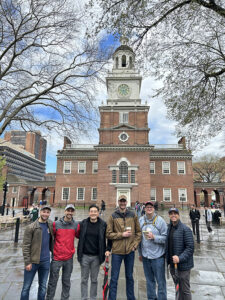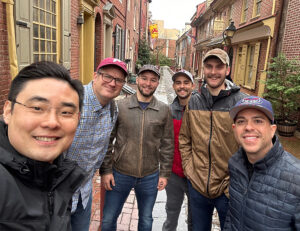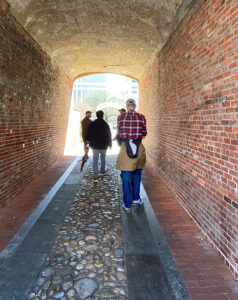When visiting the campus of Lancaster Bible College, marking its 90th year in 2023, it can be easy to miss how close it is to several important places where the birth of evangelicalism happened in the 18th and 19th centuries.
For instance, a mere 10-minute drive will take you to Long’s Barn. This was the site of revival in 1767, led by German Reformed preacher Phillip Otterbein and Mennonite pastor Martin Boehm. This revival birthed two new denominations, the United Brethren in Christ and the Evangelical United Brethren Church.
Drive 20 minutes to New Holland, Pa., and you will find yourself at the home of Jacob Albright, who founded a German Methodist movement in central Pennsylvania, which would later become the Evangelical Congregational Church. Today in nearby Reading, Pa., Albright College takes its name from this German itinerant.

Dr. Mark Draper, in light blue shirt, led students and faculty on a “field trip” to Philadelphia to explore America’s church history.
Travel an hour and 15 minutes on the Pennsylvania Turnpike and you are in Philadelphia. Pennsylvania’s founder, William Penn, developed the colony with the Quaker ideal of religious toleration. It is for this reason that Philadelphia has such a rich early American church history.
To help LBC students better learn about the evangelical heritage, faculty member and library director Dr. Mark Draper took a few students, faculty and staff to Philadelphia this spring to visit the sites and let them walk the very streets where the evangelical movement began. The students were part of an independent study on Early American History, yet not all the students were enrolled in the class; some heard about the trip and asked if they could tag along. The trip was such a great success, Dr. Draper plans to build trips such as these into more classes and even record materials for LBC | Capital online courses on the sites of key locations in church history.
On this Philly field trip, the LBC travelers learned about William Penn’s invitation to Anabaptists to settle in Pennsylvania to escape persecution in Europe. The area then become a haven for Huguenots (French Calvinists) after Protestants were expelled from France in 1685, and Philadelphia also became home to several other religious groups. Today in Philadelphia, you can visit the first Presbyterian church in America (First Presbyterian Church), as well as some of the earliest Quaker, Mennonite, Methodist (Historic St. Georges), Episcopal (Christ Church), German Reformed (First Reformed), Lutheran (Old Swedes Lutheran Church) and Baptist churches (Pennepack Baptist) in America.
The religious atmosphere in Philadelphia in the 18th century was the backdrop to the birth of evangelicalism when itinerant Anglican pastor George Whitefield from England preached the good news of the “new birth” to thousands of people in city streets, on courthouse steps or in open fields. The effect of Whitefield on Philadelphia and the Delaware Valley was noticed by none other than the most famous Philadelphian of the day, Benjamin Franklin. In his autobiography, Franklin provides us with detailed descriptions of Whitefield’s revivals and effects on the city as well as the way Whitefield’s preaching even caused Franklin to empty his pockets into a collection plate for Whitefield’s orphanage.
Today you can visit Franklin’s printshop on Market Street and see the very place where Whitefield’s sermons were printed and sent around the colonies, which helped to build his fame and spread the word about evangelical religion. The deist Franklin developed a lifelong friendship with Whitefield. As to Franklin accepting Whitefield’s message, Franklin tells us in his autobiography, “He (Whitefield) used indeed sometimes to pray for my conversion, but never had the satisfaction of believing that his prayers were heard. Ours was a mere civil friendship, sincere on both sides, and lasted to his death.”

Students and their professors take a break for a selfie while walking the historic streets of Philadelphia.
In many ways, Franklin helped make Whitefield a household name in the Anglo-American world. When local churches refused Whitefield the pulpit and he was forced to preach in the streets, Franklin raised funds to build a building for Whitefield at Fourth and Arch streets. That building would later become the first building to house the University of Pennsylvania.
While Whitefield and local preachers such as Gilbert Tennent were teaching evangelical religion in the region, Presbyterian missionary David Brainard traveled throughout the Susquehanna and Delaware valleys teaching the gospel to the native peoples. Today, a historic marker in Easton commemorates his activities.
The revivals in Philadelphia in the 18th and 19th centuries moved people to live out their faith in new ways—from women such as Hannah Hodge (Charles Hodge’s aunt), who traveled across the Delaware Valley to hear revival sermons and being thrown out of her home for embracing the new birth, to Jacob Green, a Presbyterian pastor who became an abolitionist due evangelical preaching. The revivals in the 18th and 19th centuries birthed benevolent organizations, and the remnants can still be found throughout Philadelphia if you look hard enough. There is Eastern State Penitentiary, which was designed as part of the prison reform movement. There are buildings with the names of Bible societies and track societies, and Sunday school unions are still etched on the facades of buildings even though the ministries are long gone.
Like other colonial cities, Philadelphia had a mixed history with slavery. Slaves were bought and sold in the colony, but because Philadelphia was founded by Quakers, there was a semblance of an anti-slavery presence early in the colony’s history, which includes the first anti-slavery petition in 1688 in Germantown led by Quakers and Mennonites. Quakers would not ban slave-holding until the time of the Revolution, but by the early 19th century, Philadelphia was a hub for anti-slavery activity. In 1837-38, Pennsylvania Hall was built with the support of evangelical abolitionists as a venue for abolitionist events but was burned down by mobs days after its opening.

The group takes in the cobblestone and brick of the City of Brotherly Love.
Due to the anti-slavery movements in Philadelphia, the city was also home to many free black people and the home of the some of the earliest black churches and denominations in America. The most famous of these is Mother Bethel Church and the founding of the African Methodist Episcopal Church. This church and denomination were founded in the 1790s, and the church still stands at 6th and Lombard streets. The denomination was founded by black Methodist pastor and former slave Richard Allen after he and Absalom Jones were admonished and removed for not praying in the black section of St. Georges Church. Jones went on to form the African Episcopal Church of St. Thomas and became the first ordained black priest of the Episcopal Church. In addition to the founding of the AME church, Philadelphia is also home of the first African Presbyterian church, founded by former slave John Glouchester in 1807. Many important black abolitionists such as William Still, who was a conductor on the Underground Railroad, were members.
These are just a few of the stories about early American church history that took place in the within driving distance of Lancaster Bible College’s present campus and its original campus in Lancaster City—and even a shorter distance from LBC | Capital’s Philadelphia site. Long before God called LBC founder and first president Henry Heydt to start a Bible college in Lancaster in 1933, God had been doing mighty works for centuries through his people in and around what would become the campus of Lancaster Bible College.
(Church Historian Dr. Mark Draper is Director of Library Services and a faculty member at Lancaster Bible College | Capital Seminary & Graduate School. He earn his PhD in Historical Theology from Trinity Evangelical Divinity School, along with two masters degrees from Drexel University and Bible Seminary and a bachelor’s degree in history from Temple University. His research interests include the history of evangelicalism and 18th and 19th century evangelical social reformers and theologians.)